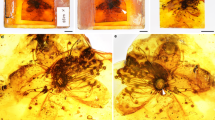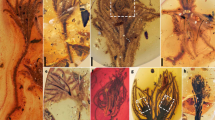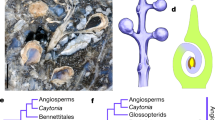Abstract
The angiosperme, or flowering plants, are believed to have originated and diversified during the Cretaceous. The earliest angiosperm fossils are pollen and leaf impressions found in late early Cretaceous strata1,2. We now describe the discovery of fossil flowers in the Upper Cretaceous of Sweden which represent a significant addition to our very limited knowledge of the floral structure of Cretaceous angiosperms.
This is a preview of subscription content, access via your institution
Access options
Subscribe to this journal
Receive 51 print issues and online access
$199.00 per year
only $3.90 per issue
Buy this article
- Purchase on Springer Link
- Instant access to full article PDF
Prices may be subject to local taxes which are calculated during checkout
Similar content being viewed by others
References
Doyle, J. A. & Hickey, L. J. in Origin and Early Evolution of Angiosperms (ed. Beck, C. B.) 139–206 (Columbia University Press, New York, 1976).
Hughes, N. F. Bot. Rev. 43, 105–127 (1977).
Hickey, L. J. & Doyle, J. A. Bot. Rev. 43, 3–104 (1977).
Beck, C. B. (ed.) Origin and Early Evolution of Angiosperms, 1–341 (Columbia University Press, New York, 1976).
Kemp, E. M. Palaeontology 11, 421–434 (1968).
Wolfe, J. A., Doyle, J. A. & Page, V. M. Ann. Mo. bot. Gdn 62, 801–824 (1975).
Knobloch, E. Sb. geol. Ved, Rada TG 19, 79–132 (1977).
Dilcher, D. L., Crepet, W. L., Beeker, C. D. & Reynolds, H. C. Science 191, 845–856 (1976).
Dilcher, D. L. Rev. Palaeobot. Palynol 27, 291–328 (1979).
Takhtajan, A. L. Flowering Plants, Origin and Dispersal, 1–310 (Oliver & Boyd, Edinburgh, 1969).
Hutchinson, J. Evolution and Phylogeny of Flowering Plants, 1–717 (Academic, London and New York, 1969).
Stopes, M. C. & Fujii, K. Phil. Trans. R. Soc. B201, 1–90 (1910).
Tiffney, B. H. Nature 265, 136–137 (1977).
Grönwall, K. A. Sver. geol. Unders. Afh. C261, 1–185 (1915).
Lundegren, A. Geol. För. Stockh. Förh. 53, 298–320 (1931).
Ross, N. E. Bull. geol. Instn Univ. Upsala 34, 25–43 (1949).
Skarby, A. Acta Univ. Stockh. 16, 1–60 (1968).
Cope, M. J. & Chaloner, W. G. Nature 283, 647–649 (1980).
Scott, A. C. & Collinson, M. E. in Scanning Electron Microscopy in the Study of Sediments (ed. Whally, B.) 137–167 (Geo-Abstracts, Norwich, 1978).
Alvin, K. L. Palaeontology 17, 587–598 (1974).
Conwentz, H. Die Flora des Bernsteins, 2. Die Angiospermen des Bersteins, 1–140 (Danzig, 1886).
Author information
Authors and Affiliations
Rights and permissions
About this article
Cite this article
Friis, E., Skarby, A. Structurally preserved angiosperm flowers from the Upper Cretaceous of southern Sweden. Nature 291, 484–486 (1981). https://doi.org/10.1038/291484a0
Received:
Accepted:
Issue Date:
DOI: https://doi.org/10.1038/291484a0
This article is cited by
-
Chloranthaceous floral structures from the Late Cretaceous of Sweden
Plant Systematics and Evolution (1997)
-
Archamamelis, hamamelidalean flowers from the Upper Cretaceous of Sweden
Plant Systematics and Evolution (1991)
-
Questions of flower power
Nature (1988)
-
Protomonimia kasai-nakajhongii gen. et sp. nov.: A permineralized magnolialean fructification from the mid-Cretaceous of japan
The Botanical Magazine Tokyo (1988)
Comments
By submitting a comment you agree to abide by our Terms and Community Guidelines. If you find something abusive or that does not comply with our terms or guidelines please flag it as inappropriate.



